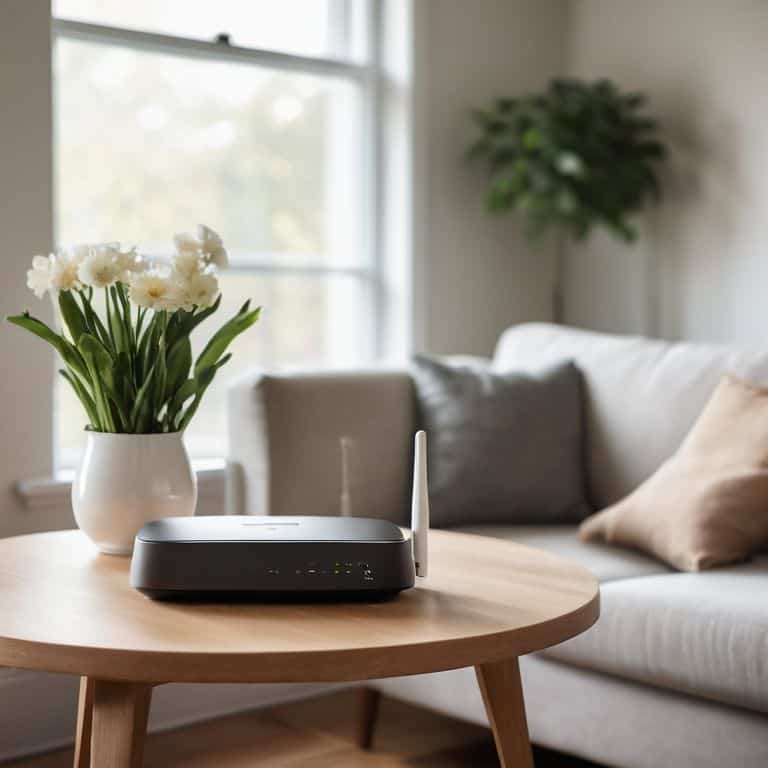I still remember the frustration of dealing with a weak WiFi signal in my own home. It seemed like no matter where I placed the router, there were always dead spots where my devices just couldn’t connect. I’ve heard people say that to improve your WiFi signal at home, you just need to buy a more expensive router, but I’m here to tell you that’s not always the case. In fact, learning how to improve your wifi signal at home can be a game-changer, and it’s often more about understanding how WiFi works than just throwing money at the problem.
As someone who’s worked with complex electronics for years, I’ve learned that the key to a strong WiFi signal is not just about the hardware, but also about understanding the environment in which it operates. In this article, I’ll share my personal tips and tricks for how to improve your wifi signal at home, from simple router placement tweaks to more advanced techniques for optimizing your network. My goal is to give you the practical advice you need to take control of your home WiFi and make it work for you, not against you.
Table of Contents
- Guide Overview: What You'll Need
- Step-by-Step Instructions
- How to Improve Your Wifi Signal at Home
- 5 Simple Hacks to Supercharge Your Home WiFi
- Key Takeaways for a Stronger WiFi Signal
- The Key to Unlocking a Stronger WiFi Signal
- Wrapping Up: Stronger WiFi for a Smarter Home
- Frequently Asked Questions
Guide Overview: What You'll Need

Total Time: 1 hour 30 minutes
Estimated Cost: $20 – $100
Difficulty Level: Easy
Tools Required
- Laptop or Smartphone (for wifi analysis)
- Drill (for mounting equipment)
- Measuring Tape (for optimal router placement)
- Level (for ensuring proper installation)
- Screwdriver (for securing devices)
Supplies & Materials
- Wifi Router (if upgrading)
- Wifi Range Extender (for expanded coverage)
- Ethernet Cables (for wired connections)
- Router Mounting Kit (for wall mounting)
- Furniture or Shelves (for elevating router 3 feet off the floor)
Step-by-Step Instructions
- 1. First, let’s get started with the basics: understanding your WiFi network. To improve your WiFi signal, you need to know how it’s currently performing. Take a few minutes to walk around your home with your smartphone or laptop, and observe the signal strength in different areas. This will give you an idea of where the signal is strong and where it’s weak. You can use apps like WiFi Analyzer to get a better view of your network’s performance.
- 2. Next, it’s time to optimize your router’s location. Think of your router as a water fountain, and the WiFi signal as water flowing out of it. If you place the fountain in a corner, the water won’t reach the other side of the room, right? Similarly, your router should be placed in a central location, preferably at a high point, to ensure the signal can spread evenly throughout your home. Avoid hiding it behind furniture or in a closed cabinet, as this can significantly weaken the signal.
- 3. Now, let’s talk about interference from other devices. Just like how a crowded radio frequency can disrupt your favorite station, other devices in your home can interfere with your WiFi signal. Try to move devices like cordless phones, microwaves, and baby monitors away from your router, as they can cause electromagnetic interference. You can also change the WiFi channel on your router to one that’s less crowded, using tools like WiFi Scanner to find the best option.
- 4. It’s time to upgrade your router’s firmware. Think of firmware like the operating system of your router. Just as you update your smartphone’s OS to get the latest features and security patches, you should also keep your router’s firmware up to date. This can improve the performance and security of your WiFi network. Check your router manufacturer’s website for updates, and follow their instructions to upgrade the firmware.
- 5. To further boost your WiFi signal, consider using a range extender. A range extender is like a relay runner, picking up the signal from your router and passing it on to the next leg of the journey. This can help extend the signal to areas of your home that were previously out of range. Place the range extender halfway between your router and the area you want to cover, and follow the manufacturer’s instructions to set it up.
- 6. Another way to improve your WiFi signal is to use Quality of Service (QoS) settings. QoS is like a traffic cop, directing the flow of data on your network to ensure that critical applications like video streaming and online gaming get priority. By setting up QoS on your router, you can prioritize the devices and applications that need a strong, stable connection. Check your router’s manual to see if it supports QoS, and follow the instructions to set it up.
- 7. Finally, let’s not forget about physical barriers that can affect your WiFi signal. Walls, floors, and ceilings can all weaken the signal, especially if they’re made of thick materials like concrete or brick. If you have a large home or a lot of obstacles, consider using a mesh network system, which uses multiple access points to provide a strong, reliable signal throughout your home. These systems can be more expensive, but they’re a great option if you need to cover a large area.
How to Improve Your Wifi Signal at Home

As we dive deeper into enhancing our home WiFi experience, it’s essential to consider optimal wifi router placement. Think of your router as a water fountain – its effectiveness depends on where it’s placed in the room. If you put it in a corner, the water (or in this case, the WiFi signal) won’t reach far. By placing your router centrally, you can ensure a more even distribution of the signal.
To further boost your WiFi, let’s talk about reducing wifi interference at home. This can be achieved by changing the WiFi channel on your router. Imagine you’re at a crowded coffee shop with multiple radios playing different stations – it’s hard to tune in to your favorite channel, right? It’s similar with WiFi channels. By switching to a less crowded channel, you can minimize interference and enjoy a stronger signal.
For those with larger homes or more complex layouts, improving wifi range and coverage might require additional solutions. This is where best mesh network systems come into play. These systems use multiple access points to provide a robust and reliable WiFi connection throughout your home. By installing a mesh network, you can ensure that every room, no matter how far from the router, receives a strong and stable WiFi signal.
Optimal Router Placement Secrets
Optimal router placement is key to a strong WiFi signal. Think of your router as a water fountain – its signal radiates outward, filling the space around it. To maximize coverage, place your router centrally, avoiding walls and corners that can block or absorb the signal. Imagine the water from the fountain hitting a wall and splashing back, reducing its reach. By positioning your router in an open area, you allow its signal to flow freely, reaching more of your home.
Reducing Interference for Better Coverage
To reduce interference, think of your WiFi signal like water flowing through pipes. Just as leaks or clogs can disrupt water flow, other devices in your home can disrupt your WiFi signal. Common culprits include microwaves, cordless phones, and neighboring WiFi networks. Try to place your router away from these devices to minimize interference. You can also change the WiFi channel on your router to one that’s less crowded, much like switching to a less busy lane on the highway to avoid traffic jams. This simple tweak can significantly improve your signal strength and reliability.
5 Simple Hacks to Supercharge Your Home WiFi

- Move Your Router to a Central Location: Think of your WiFi signal like water flowing through a house – it needs a clear path to reach all the rooms, so try placing your router in a central spot to get the best coverage
- Upgrade to a WiFi Range Extender: These handy devices can help boost your signal to those hard-to-reach areas, like the backyard or upstairs bedrooms, by essentially repeating the signal to extend its range
- Switch to the 5GHz Frequency: Most modern routers have both 2.4GHz and 5GHz frequencies – the 5GHz band is generally less crowded, which means faster speeds and less interference, so try switching to it for a better connection
- Use a WiFi Analyzer App: These apps can help you identify which channels are being used by nearby networks, allowing you to switch to a less crowded one and reduce interference – it’s like finding a clear channel on your radio
- Update Your Router’s Firmware: Keeping your router’s software up to date is crucial for maintaining a strong and secure connection – it’s like getting a tune-up for your car, it keeps everything running smoothly and efficiently
Key Takeaways for a Stronger WiFi Signal
Place your router in a central location, away from walls and obstructions, to ensure optimal coverage and reduce dead spots
Reduce interference from other devices by switching to the 5GHz frequency band and changing the WiFi channel on your router to minimize overlap with neighboring networks
Regularly update your router’s firmware and consider upgrading to a newer model with better range and throughput capabilities to future-proof your home WiFi network
The Key to Unlocking a Stronger WiFi Signal
Improving your WiFi signal at home is not just about tweaking settings, it’s about understanding how the signals flow through your space like water through pipes – once you grasp that, you can start making deliberate decisions to enhance your coverage and speed.
Chloe Brennan
Wrapping Up: Stronger WiFi for a Smarter Home
As we’ve explored, improving your WiFi signal at home is all about understanding the basics and making a few strategic adjustments. From optimal router placement to reducing interference, each step plays a crucial role in strengthening your network. By applying these principles, you’ll not only enjoy faster internet but also a more reliable connection, perfect for streaming, gaming, or working from home. Remember, it’s not just about the tech itself, but how you choose to utilize it to enhance your daily life.
So, as you embark on this journey to tame your home WiFi, keep in mind that empowerment through knowledge is the ultimate goal. By grasping how your technology works and making informed decisions, you’re not just fixing a frustrating problem – you’re future-proofing your home for the innovations to come. And that’s a pretty exciting thought, isn’t it? The world of tech is ever-evolving, but with a solid foundation, you’ll be ready to embrace whatever comes next, making your life easier, more enjoyable, and truly connected.
Frequently Asked Questions
What are some common obstacles in my home that could be blocking my WiFi signal?
Think of your WiFi signal like water flowing through pipes – it can get blocked by obstacles. In your home, common culprits include thick walls, metal appliances, and even furniture. These can absorb or reflect the signal, weakening it. Try to position your router in a central spot, away from these barriers, to help the signal flow freely.
How often should I restart my router to ensure optimal performance?
Think of your router like a computer – it needs a refresh sometimes. I recommend restarting it every 1-3 months, or when you notice a slowdown. This simple reboot can clear out temporary issues and get your WiFi running smoothly again, kind of like how a quick drain flush can get your plumbing flowing freely.
Can using multiple routers or WiFi extenders in my home actually improve my overall WiFi coverage?
Using multiple routers or WiFi extenders can definitely boost your coverage, but think of it like plumbing – adding more pipes can help, but if they’re not connected right, you’ll still have leaks. Essentially, you want to ensure they’re configured to work together seamlessly, like a team, to provide a strong and consistent signal throughout your home.







